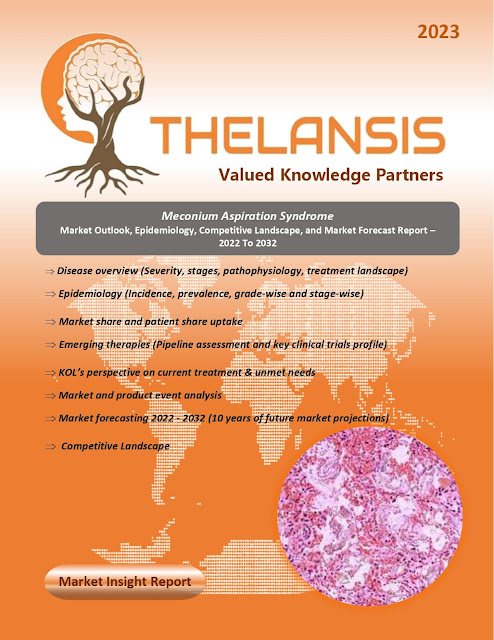Meconium Aspiration Syndrome (MAS) – Market Outlook, Epidemiology, Competitive Landscape, and Market Forecast Report – 2022 To 2032
Meconium aspiration syndrome (MAS) refers to respiratory distress observed in newborns when meconium-stained amniotic fluid (MSAF) is present. The symptoms of meconium aspiration can vary among infants. However, the following are commonly observed Rapid or labored breathing, Retractions, which involve inward pulling of the chest wall; Grunting sounds during breathing; bluish skin color (cyanosis); Low Apgar score, which assesses a newborn's color; heart rate, reflexes, muscle tone, and respiration immediately after birth, Limp body. Various risk factors contribute to meconium aspiration, including Post-term pregnancy, Preeclampsia, Maternal diabetes, Maternal hypertension, Difficult delivery, Fetal distress, and Intrauterine hypoxia, a condition in which the fetus receives insufficient oxygen while still in the uterus. The inhalation of meconium-stained amniotic fluid causes meconium aspiration. MSAF is a common finding and does not always lead to MAS. Uterine stress resulting from hypoxia or infection can cause the passage of meconium before birth. Meconium differs from regular infant stool as it is darker and thicker. It comprises fetal cellular debris (skin, gastrointestinal tissue, and hair) and secretions. Inhalation of these materials obstructs the airways, triggers inflammation, and impairs surfactant function. These mechanisms contribute to the development of respiratory distress in the newborn. The exact pathophysiology of MAS is not fully understood, but five important processes have been identified: meconium passage, aspiration, airway obstruction, inflammation, and surfactant inactivation. The treatment approach for meconium aspiration depends on factors such as the amount and thickness of the meconium, the duration of exposure, and the severity of respiratory problems experienced by the newborn.
·
In the United States, MAS incidence ranges
from 0.7-3.8/1000 births, varying with gestational age, birth year, and race.
Thelansis’s “Meconium Aspiration
Syndrome (MAS) Market Outlook, Epidemiology, Competitive Landscape, and Market
Forecast Report – 2022 To 2032" covers disease overview, epidemiology,
drug utilization, prescription share analysis, competitive landscape, clinical
practice, regulatory landscape, patient share, market uptake, market forecast,
and key market insights under the potential Meconium Aspiration Syndrome (MAS)
treatment modalities options for eight major markets (USA, Germany, France,
Italy, Spain, UK, Japan, and China).
KOLs insights
of Meconium Aspiration Syndrome (MAS) across 8 MM market from the centre of
Excellence/ Public/ Private hospitals participated in the study. Insights
around current treatment landscape, epidemiology, clinical characteristics,
future treatment paradigm, and Unmet needs.
Meconium Aspiration Syndrome (MAS) Market Forecast Patient
Based Forecast Model (MS. Excel Based Automated Dashboard), which Data Inputs
with sourcing, Market Event, and Product Event, Country specific Forecast
Model, Market uptake and patient share uptake, Attribute Analysis, Analog
Analysis, Disease burden, and pricing scenario, Summary, and Insights.
Thelansis Competitive Intelligence (CI) practice
has been established based on a deep understanding of the pharma/biotech
business environment to provide an optimized support system to all levels of
the decision-making process. It enables business leaders in forward-thinking
and proactive decision-making. Thelansis supports scientific and commercial
teams in seamless CI support by creating an AI/ ML-based technology-driven
platform that manages the data flow from primary and secondary sources.




Comments
Post a Comment